 This month’s picture book creator interview is with Kristen Balouch, an author, illustrator, artist, and designer living in Brooklyn. Few creatives give as much access to their workspace in the way Kristen does: “I live in a tiny apartment in Williamsburg, Brooklyn that I renovated with salvaged finds. I designed the apartment around this twelve-foot table. Everything happens at this table: manuscript sorting, book illustrations, editorial illustrations, hand-lettering, fabric collections, daydreaming, birthday cakes, and dinner parties.”
This month’s picture book creator interview is with Kristen Balouch, an author, illustrator, artist, and designer living in Brooklyn. Few creatives give as much access to their workspace in the way Kristen does: “I live in a tiny apartment in Williamsburg, Brooklyn that I renovated with salvaged finds. I designed the apartment around this twelve-foot table. Everything happens at this table: manuscript sorting, book illustrations, editorial illustrations, hand-lettering, fabric collections, daydreaming, birthday cakes, and dinner parties.”
Here’s a photo of that cool space!
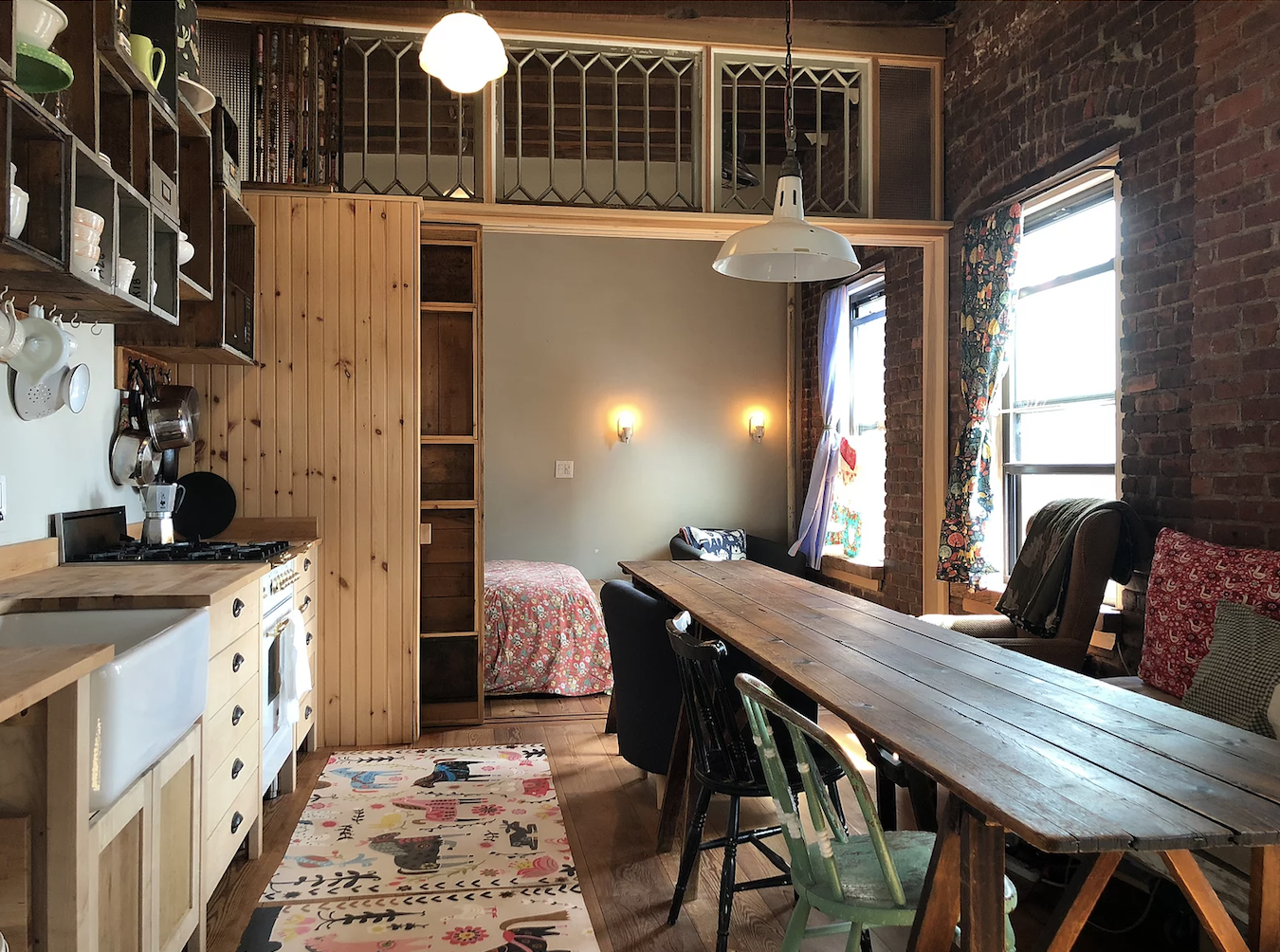
Kristen has created a number of her own picture books such as Feelings and The Little Little Girl with the Big Big Voice, and she’s illustrated the work of others, as with Baby Polar. Her most recent book is the picture book If You Are the Dreamer, which arrives this month.
She also runs Little Blue Mushroom, a “literary agency for children’s books.” (More on this in a minute.)
Let’s get to the interview to find out more about all the cools things Kristen is doing.
RVC: Let’s start with an easy one. As a child, what was your favorite picture book?
KB: The first books I remember reading were Roald Dahl books—Fantastic Mr. Fox and James and the Giant Peach. My grandma lived in Ohio and we lived in California. I think she knew no one was taking me to the library and so she would mail packages of books to me.
RVC: Grandmas like that are the best. What else about your childhood set you up for a career in children’s books?
KB: I lived in among the redwoods of California and we were in no way confined as children. It was me, my sister, and our dog Wonder Dog. We ran, explored, and daydreamed in between the redwoods and along the Russian River.
RVC: In what ways was your creativity coming through during high school?
KB: We moved to Ohio and I had a wonderful art teacher in high school. His name was John Antro. He put the idea of art school and New York City in my mind. My family moved in the middle of high school to Florida and I was devastated. But I was lucky and landed in another school with another amazing art teacher, Roger Smith. These two teachers—their vision, their encouragement—altered the course of my life. Teachers change lives!
RVC: Indeed they do! Now, you went to the Pratt Institute as an undergraduate. What drew you to that school?
KB: When I was 14, I lied and said I was 16 to work the weekends at a fried chicken place. I saved all my money—I think it was $800, something like that–and used it to go to Pratt for a high school program in the summer. Pratt had a campus which made it feel more like a school experience than a city experience.
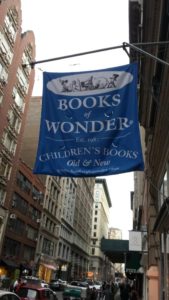 Later, as an undergraduate there, I had the most wonderful English professor, Daniel Gerzog, and I started working on picture books. I also explored New York City. My favorite spot was Books of Wonder. I passed the afternoons with the picture books there.
Later, as an undergraduate there, I had the most wonderful English professor, Daniel Gerzog, and I started working on picture books. I also explored New York City. My favorite spot was Books of Wonder. I passed the afternoons with the picture books there.
RVC: Your undergraduate experience at Pratt was a while back. But you recently went back to college via the low-residence MFA in Writing for Children at Vermont College of Fine Arts. What was the goal?
KB: I felt like I had the art down, but the writing! I just fumbled with words. I went to VCFA and I witnessed the craft of writing and the devotion. It looked the same as my art practice but with words, and I could also see that the components of the book were the same…character development, environment, suspense, story arc. It was just using words to get there instead of color or composition.
RVC: What was the most valuable lesson you learned at VCFA?
KB: I think I learned to trust my words on paper.
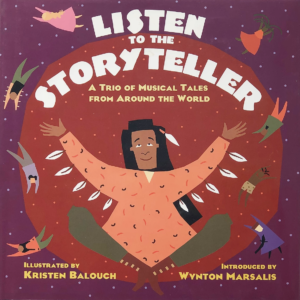 RVC: Let’s get to your books. What’s the story behind your first picture book, Listen to the Storyteller? How did that come about?
RVC: Let’s get to your books. What’s the story behind your first picture book, Listen to the Storyteller? How did that come about?
KB: I had sent a book dummy for The King & the Three Thieves to Viking. They were publishing Simms Taback at the time and I adored everything they printed. And then they said “Yes!” But they said we have something else first. It was Listen to the Storyteller.
RVC: What’s your favorite thing about that book?
KB: I look back at those illustrations and the compositions are so expressive. I was learning how to use placement and form to tell a story.
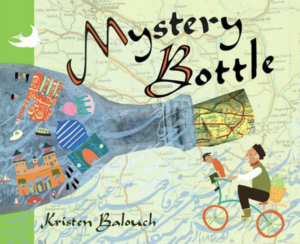 RVC: One of my favorites of yours is the Ezra Jack Keats award-winning picture book Mystery Bottle. Care to share the close-to-home story that inspired it?
RVC: One of my favorites of yours is the Ezra Jack Keats award-winning picture book Mystery Bottle. Care to share the close-to-home story that inspired it?
KB: Mystery Bottle is like collecting a family history, political borders, and ways of life then sprinkling those details throughout a book. The initial spark was my son’s grandparents and how much they wanted to meet their grandson, but the gap between here and Iran seemed so enormous. It was a way to bring them together.
RVC: On one hand, the story is kind of nonfiction. But things happen in it that aren’t quite realistic in a traditional sense. How do you handle that challenge in terms of creating visuals (which many reviewers note is their favorite thing about the book)?
KB: There are so many ways to see and experience reality. For example, let’s say there are two things on the table that are approximately the same size. If one of those things is important to me, then maybe I would draw it larger. Or maybe that thing is so important to me that it might fill the whole room. Or maybe that thing is so important to me that it fills the entire page. In that example of scale, all of those images would represent a reality. It may just not be the reality we are used to seeing.
RVC: That’s a great point about perspective. I’m not sure writers fully understand all that an illustrator does. Speaking of that…what’s the most important thing writers should know or understand about picture book illustrators?
KB: I think writers do know that illustration is also storytelling and that can enhance or add layers of meaning. Personally, I like to illustrate a roomy text that allows for a broad interpretation.
RVC: Since you brought up interpretation…what do you think about art notes?
KB: Art notes can be necessary if the author is considering a specific visual that tells the story. Other art notes can be micro managing. People have different ways of working. Some people like to be told what to do. But I am not one of those people. Most publishers make sure illustrators have the room to create.
RVC: You’ve been doing freelance work beyond kidlit things for a very long time. How does that work inform your kidlit illustrations?
KB: When art is out in the world, it doesn’t have the same proximity or amount of time with the viewer as children’s books. Images need to be more immediate and compelling—the messaging needs to be clear. The luxury of time and proximity in children’s books creates an environment for play and dialogue. I hope my work has become better as a communicator from creating for different viewers.
RVC: What are your thoughts on the state of kidlit in general right now?
KB: Could you ever imagine this many beautiful books being produced?
The extraordinary, thoughtful books being published every season just takes my breath away. Small presses and imprints acting as small presses are creating diverse books, neurologically and otherwise, which broaden the picture book market. It’s very exciting!
I wish more obscure books became less obscure and made their way into more readers’ hands.
RVC: Here’s a question I’ve never asked in an OPB interview before. How do you go about making a quality artist’s statement? (P.S.—this is something unique to artists. Writers don’t worry about such things!)
KB: I suppose first you have to think about who will be reading your artist statement and how to connect with them. I like to include things that are important to me and the things that make me tick. Like…I like kindness and poetry and little things that dance around in the background of a page. But then if you put that into a context where your reader values awards or accomplishments, well, then I would include some of those, too.
It’s a little scary defining oneself on paper. Be brave, speak truth, walk boldly even if it’s uncomfortable!
RVC: What is Little Blue Mushroom?
KB: Little Blue Mushroom is this incredible thing that happened almost on its own–just add water!
I started teaching online courses about five years ago. I wanted to help illustrators find their way into the children’s book market. I had so many years of trying to figure out how to create story as an illustrator. I looked for access points into storytelling. I put together the things that I thought were helpful and were from the point of view of the illustrator and created a handful of courses.
The response was tremendous. So many very talented illustrators showed up. Little Blue Mushroom organically evolved into a boutique literary agency to help a half dozen of those illustrators bring their work to publishers.
RVC: Any tips for writers or artists who decide to follow in your path and create a similar company?
KB: Be generous with what you can offer. Pay attention and do what’s important to you, and it will grow.
RVC: Brag time. What’s a current or forthcoming project you’re super stoked about?
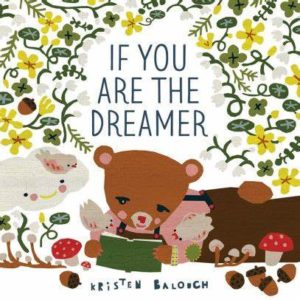 KB: If You Are the Dreamer is coming out Sept 21st with Cameron Kids. It’s sort of like a contemporary Runaway Bunny in its simplicity and poetry. I’m counting down the days!!! Check back with me in the spring for more exciting news, too!
KB: If You Are the Dreamer is coming out Sept 21st with Cameron Kids. It’s sort of like a contemporary Runaway Bunny in its simplicity and poetry. I’m counting down the days!!! Check back with me in the spring for more exciting news, too!
RVC: Last question for this part of the interview. You’re back at Pratt again, but as a teacher this time. What’s that like for you?
KB: I love encouraging people/students to see a way to bring what they love to the world. There is room in the world to do exactly what you want to do. I also like to help swat away any nay-saying self talk–get outta here!
RVC: Okay, it’s time for the Speed Round. Zoomy questions and zippy answers, please. Ready?
KB: Ready!
RVC: Best place in Brooklyn for cupcake?
KB: Bakeri in Greenpoint or Williamsburg.
RVC: Your three favorite colors, in order, are…
KB: I have four! Strawberry ice cream pink, bright persimmons orange, electric pure yellow, and a hazy gray blue.
RVC: “If I weren’t creating art or writing, I’d be…”
KB: A therapist or a gardener!
RVC: Five things you can’t do your work without.
KB: Focus, sleep, a full belly, a Sharpie, and a piece of paper.
RVC: If you could illustrate for any living picture book writer, it’d be…
KB: Carole Boston Weatherford.
RVC: [Quick sidenote–check out the OPB interview with Carole right here!] Your illustration philosophy in five words or less.
KB: Be kind.
RVC: Thanks so much, Kristen. Best of luck with the new book!
KB: Thank you!

